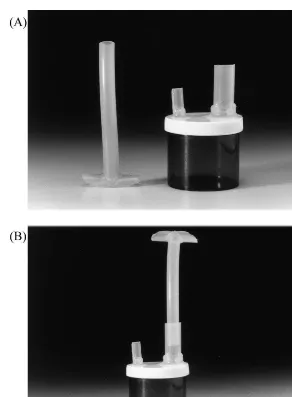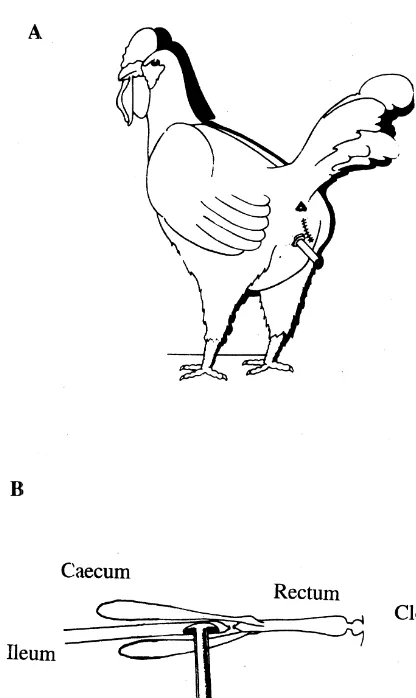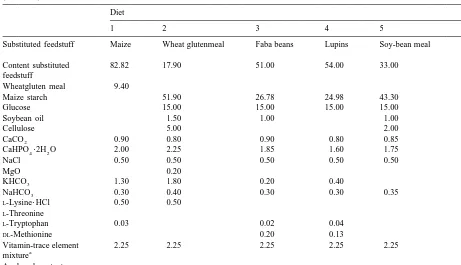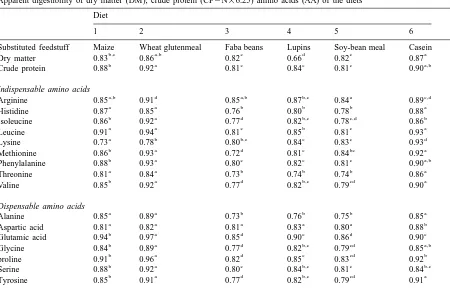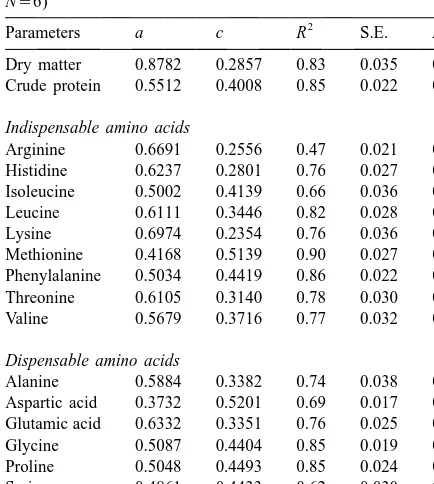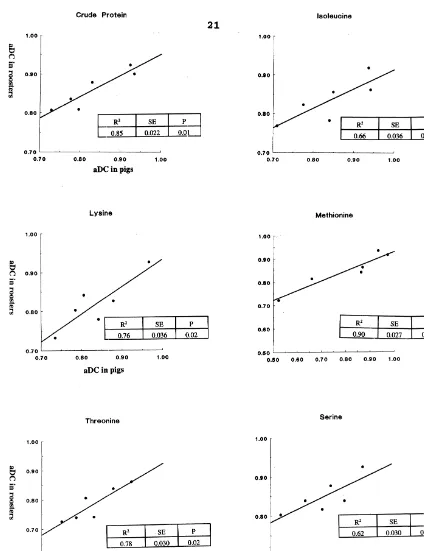www.elsevier.com / locate / livprodsci
A procedure for ileostomisation of adult roosters to determine
apparent ileal digestibility of protein and amino acids of diets:
Comparison of six diets in roosters and growing pigs
a ,
*
b c bP. van Leeuwen
, L. Babinszky , M.W.A. Verstegen , J. Tossenberger
a
TNO Nutrition and Food Research, Department ID TNO Animal Nutrition, P.O. Box 65, 8200 AB Lelystad, The Netherlands
b
Faculty of Animal Science Kaposvar, Pannon University of Agriculture, Pannon, Hungary
c
Department of Animal Nutrition, Agricultural University Wageningen, Wageningen, The Netherlands Received 22 January 1999; received in revised form 12 October 1999; accepted 14 February 2000
Abstract
A procedure for the ileostomisation of adult roosters has been described with the use of flexible silicon cannulas. Apparent ileal digestibility coefficients for dry matter (aDC DM), crude protein (aDC CP) and amino acids (aDC AA) in six diets, formulated with maize, wheat gluten, faba beans, lupins, soybean meal and casein as the main protein sources were determined in the ileostomised roosters fitted with silicon cannulas. In addition, aDC data determined using roosters (present study) were correlated with previously published aDC data of the same diets determined with pigs [van Leeuwen et al. (1996a). Apparent dry matter and crude protein digestibility of rations fed to pigs and determined with the use of chromic oxide (Cr203) and linsoluble ash as digestive markers. Br. J. Nutr. 76, 551-562; van Leeuwen et al. (1996b). Validation of a mathematical model to explain variation in apparent ileal amino acid digestibility of diets fed to pigs. J. Anim. Feed Sci. 5, 303-315]. The ileal aDC CP in roosters ranged from 0.81 to 0.92. Significant (P,0.05) differences in aDC CP and aDC AA were observed between diets. Between aDC in roosters and pigs linear relations were found. The linear models explained 85% of the variation in ileal aDC CP between the six diets determined in roosters and pigs. For ileal aDC AA, the explained part of the variation between roosters and pigs, ranged from 62 to 96%, depending on the particular amino acids, with the exception of aDC of Arg. The standard errors (S.E.) of the models for the prediction of the aDC AA in roosters from aDC AA of the pigs was ,0.04 units. 2000 Elsevier Science B.V. All rights reserved.
Keywords: Poultry; Pigs; Ileal digestibility; Amino acids
1. Introduction the role of the caeca and the effects of the
re-troperistaltic movement of digesta from the cloaca to
Karasawa and Maeda (1994) investigated the the caeca. The amino acids (AA) synthesized in the
nitrogen (N) metabolism of chickens with regard to caeca by microbial activity can not be used in birds
(Mortensen and Tindall, 1981). The undigested AA which reach the caeca can be deaminated by the
*Corresponding author. Tel.:131-320-237-334; fax:1
31-320-237-320. microflora but the endproducts have no nutritional
value (McNab, 1989). Moreover, Parsons (1986) composition of the digesta may occur because
observed a higher agreement between amino acid of the microbes in the cloaca of caecectomised
availability, measured in chick growth assays, and birds.
digestibility determined in caecectomised rather than An alternative method for the collection of ileal
in intact birds. This means that, in poultry, digestion digesta uses animals surgically cannulated at the
in the distal part of the intestines, more specifically terminal ileum (Fussel, 1969; Okumura, 1976;
the caeca, is mainly fermentative and that the AA Raharjo and Farrell, 1984). In these ileostomised
synthesized or disappearing in the caeca are not birds, the digesta can be directly collected from the
available for protein synthesis in the animal. cannulas without contamination with feathers or
As in poultry, it has been shown that in pigs the urine. Surgical procedures for intestinal cannulation
amino acids from proteins digested in the large of fowl have been described by Fussel (1969),
intestine do not contribute to protein synthesis in the Okumura (1976) and Raharjo and Farrell (1984)
animal (Zebrowska et al., 1978). The ratio of the using glass cannulas. More recently, flexible medical
proteins digested in the small and large intestine of silicon tubing was demonstrated to be very effective
pigs differs between ingredients (Dierick et al., for cannulations in pigs (van Leeuwen et al., 1988,
1987). So, ileal digestibility estimates amino acid 1991).
availability better than faecal digestibility. Several Slaughter method is frequently used to determine
studies have been reported on the apparent ileal ileal digestibility of diets (Radivan et al., 1999). With
digestibility of amino acids of feedstuffs in pigs. this method the small amounts of digesta are derived
Tables for pig diet formulation are commonly used from the small intestine over the 40-mm proximal
ˆ
(Degussa, 1993; van Leeuwen et al., 1993; Rhone ileal–caecal junction, on a certain moment of the
Poulenc, 1993; Eurolysin, 1995; CVB, 1998). day. This method needs many animals (40–60) to
Also in birds, the relative contribution of the distal collect enough digesta for analysis and to have a
part of the gastro-intestinal (GI) tract to protein and representative sample of the digesta over a longer
AA digestion of different feedstuffs is not constant period. Also the way of sampling is critical because
(Raharjo and Farrell, 1984; Green and Kiener, 1989; from the dead intestine easily mucosa can be scraped
Angkanaporn et al., 1997) and technological treat- off.
ments on feedstuffs may have effects on the propor- Green and Kiener (1989) have studied the relation
tion of protein digested in the different sections of between ileal digestibility values determined in
the GI tract (Johns et al., 1986). This implies that for precise-fed (force-fed) caecectomised roosters and
poultry, as in pigs, ileal digestibility values of protein the same diets determined in ileo–rectal anastomised
and amino acids in feedstuffs may give a more pigs. Even though many differences exist in the GI
accurate estimate of the amino acids potentially tract and in the digestive processes between poultry
available for protein synthesis than faecal digestibili- and pigs (Moran Jr., 1982), they found similarities in
ty data (Raharjo and Farrell, 1984). ileal digestibility of CP and AA of diets between
Apparent ileal digestibility values for poultry have both species.
been determined using caecectomised roosters The objectives of the present study were (a) to
(Green and Kiener, 1989). In caecectomised birds, describe a surgical procedure for ileostomy in
roos-digesta flows from the ileum into the rectum and ters with the use of cannulas made of flexible
cloaca where it is stored and diluted with the urine medical silicon tubing, (b) to determine the ileal
until excretion. It is usually assumed that the AA in digestibility of diets with different protein sources in
the excreta originate only from the digesta. The roosters and (c) to relate the ileal digestibility data of
amount of AA in urine has been generally assumed six diets determined in ileal cannulated roosters with
to be low and can be ignored (McNab, 1989). values previously determined for the same diets in
However, digesta in the cloaca is not sterile and cannulated pigs (van Leeuwen et al., 1996b).
urine N can be converted to amino acids in bio- The experiment was approved by the TNO
2. Materials and methods rooster was placed on its back on the surgery table and the area ventral of the pubis was cleaned with a
2.1. Experimental protocol general disinfectant. Laparotomy was performed by a
4-cm straight incision at the ventral side of the right
2.1.1. Birds and housing pubis. The ileo–ceacal junction was positioned at the
Ten adult roosters (Lohmann brown) with an incision. The intestine was closed with two
absorb-average body weight (BW) of 2.8 kg were indi- able sutures (Polysorb GL-181 / CV-25) around the
vidually housed in metabolic galvanized wire mesh terminal ileum, with a distance of 3 mm between the
cages (40375360 cm, width3height3depth) sutures. The ileum was transected between the
with a feed and water bowl. No bedding was sutures. A purse string suture (Polysorb GL-181 /
CV-provided. The cages were placed in an environmen- 25) was placed at the antimesenteric side of the
tally controlled room with an air temperature of proximal part of the transsected intestine. An
inci-19–218C. Birds were maintained under a 16 h light sion was made in the intestine between the purse
with 8-h twilight cycle throughout. string suture, the flange of the cannula was inserted
and fixed immediately with the ligature. A second
2.1.2. Surgical procedure for ileostomy ligature was placed around the cannula. The cannula
The principle of the surgical procedure used in the was then exteriorized through a stab incision in the
present experiment was previously described by body wall about 2 cm ventral of the first incision
Schutte et al. (1991). From 3 weeks prior to the (Fig. 2). After a routine closure of the laparotomy,
surgeries and for 3 weeks post-surgery the roosters the cannula was fixed externally with tape, so that
were fed a highly digestible diet with soy flour meal the intestine and the abdominal wall just came in
(410 g / kg), maize starch (180 g / kg), glucose (200 light contact with each other. Too much pressure
g / kg), cellulose (Arbocel, 100 g / kg) and a premix of would increase local necrosis. After a period of 3
vitamins and minerals mixed with maize (110 g / kg). weeks, the digestibility trial started. Time needed for
The cannulas consisted of a barrel with a flange (Fig. surgery was, included the introduction of the
anaes-1), both segments of the same medical grade silicon thesia, about 1 h. The number of animals alive after
tubing, Type SR 16 (Maxxim B.V., s’Hertogenbosch, 2 months was over 90%.
The Netherlands), with an 8 mm inner diameter (ID)
and an 11 mm outside diameter (OD). The barrel and 2.2. Experimental diets
the flange were glued together with a silicon
ad-hesive, Elastosil E41 (Wacker-Chemie GmbH, After a pre-test period of 3 weeks, the roosters
¨
Munchen, Germany). were fed maize starch based diets with maize (diet
Feed was removed 24 h prior to surgery, but water 1); wheat gluten (diet 2); faba beans with a low
was always freely available. Each rooster was pre- tannin content (LT) (diet 3); lupins, angustifolius,
medicated with an intramuscular injection of 1 mg of white (diet 4); soybean meal (diet 5) and casein (diet
Ketamin (Nimatec , Eurovet, Bladel, The Nether- 6) as main protein sources (Tables 1 and 2). The
lands; given as a sedative), 10 mg of flunixine– incorporation rates of the feedstuffs were calculated
meglumine (Finadyne , Schering Plough Animal in order to obtain diets containing 160 g / kg CP. In
Health, USA; as an analgestic), 0.3 ml of diet 1, 94 g / kg wheat gluten meal was added to
Depomycine 20 / 20 (Mycofarm, De Bilt, The elevate the CP content of the diet to 160 g / kg. The
Netherlands; as a wide spectrum antibiotic) and 0.05 same batch of the diets were used in previously
mg of atropinsulphate (Eurovet, Bladel, The Nether- conducted digestibility experiments with pigs (van
lands; as a cholinergic blocker). Oxygen (O ) with2 Leeuwen et al., 1996a,b). Diets were stored at
isoflurane as anaesthesia was then given with a 2208C for 2 years until the use in the present rooster
mask. After sedation, each rooster was intubated experiment. For the present experiment with the
(OD of the silicon rubber trachea tube was 3 mm). ileostomised roosters, the meal was more finely
Fig. 1. (A) T-shaped silastic cannula for collection of ileal digesta; (B) the cannula connected with a digesta collection bottle.
feed intake was restricted to 80 g / day, equivalent to After 11 days of adaptation to the rations, without
a semi ad libitum level. Water was freely available. fasting periods, digesta were collected over 3
succes-sive days (72 h) via a plastic bottle of about 10 g
2.3. Determination of ileal digestibility in connected to the cannula (Fig. 1). Digesta were
ileostomised roosters removed hourly over the day (8.00–20.00) and each
6 h during the night and immediately frozen
The ileal digestibility experiment consisted of four (2208C). Digesta was more frequently collected
periods (P1, P2, P3 and P4) of 14 days each. Diets during the day rather than in the night. This was
1–6 were assigned randomly with no rooster receiv- done (1) to have the possibility to compare digesta
ing the same diet twice. The digestibility coefficients composition for the two different procedures separate of each diet were determined in at least five different and (2) to keep the roosters quiet during the night,
much as possible. Unpublished results showed no systematically differences. After each experimental period, digesta of the 3 day collections were thawed and pooled per bird.
2.4. Analytical procedures
Feedstuffs, diets and freeze-dried digesta were ground through a 1-mm screen using a Retsch AM 1 grinder prior to chemical analysis. Nitrogen (N) was analyzed by the Kjeldahl method and crude protein
(CP) was calculated as N36.25. Dry matter (DM)
contents were determined after drying at 808C over-night. Amino acids were determined according to Bech-Anderson et al. (1990).
2.5. Calculations
The apparent digestibility for DM, CP and AA of the diets were calculated from nutrient intake and the total collected amounts of digesta over periods of 3 days (72 h). The crystaline amino acids included were assumed to be completely absorbed.
The data set for the calculation of the correlations between ileal aDC CP and AA were derived from the cannulated roosters in the present experiment and from cannulated pigs from the previous experiment (van Leeuwen et al., 1996b).
Fig. 2. (A) A cannulated rooster with an indication of the incision;
2.6. Statistical analysis
(B) the ileo–caecal junction and the place of the cannula.
Data were subjected to analysis of variance using
the SPSS / PC1V5.0 software (Norusis, 1992). The
Table 1 diet type was treated using the following model:
Dry matter (DM), crude protein (CP; N36.25) and crude fibre
(CFi) (% as fed) of the used feedstuffs y 5T1a3D 1e i, j i i, j
Feedstuffs DM CP CFi
where yi, j5response measurements, Di5diet type
Maize 88.5 9.5 2.6
d (i5126), T5mean value and e 5residual error.
i, j
Wheatgluten 92.1 82.2 n.d.
a The number of periods per diet was similar and a
Faba beans (LT ) 89.3 32.0 8.4
b
Lupins 92.1 28.4 14.9 first statistical analysis showed no significant effect
c
Soybean meal 90.2 48.9 4.4 of periods. Therefore the period was not included in
Casein 91.2 86.4 n.d.
the final model.
a
Low tannins, ,0.05% tannins expressed as cat. eq. (Kuhla Treatment means were tested for difference by use and Ebmeier, 1981), 1.9 mg / g trypsin inhibitor activity (TIA) of the Least Significant Difference test (Snedecor (van Oort et al., 1989).
b and Cochran, 1980). All statements of significance
0.4% Alkaloids (European Commission, 1971).
c are based on a probability of P,0.05.
3.5 mg / g TIA.
d
Table 2
Composition of the maize starch based diets with maize, wheat gluten, faba beans, lupins soybean meal and casein as substituting feedstuffs (% as fed)
Diet
1 2 3 4 5 6
Substituted feedstuff Maize Wheat glutenmeal Faba beans Lupins Soy-bean meal Casein
Content substituted 82.82 17.90 51.00 54.00 33.00 18.00
feedstuff
Wheatgluten meal 9.40
Maize starch 51.90 26.78 24.98 43.30 53.35
Glucose 15.00 15.00 15.00 15.00 15.00
Soybean oil 1.50 1.00 1.00 1.00
Cellulose 5.00 2.00 5.00
CaCO2 0.90 0.80 0.90 0.80 0.85 1.20
CaHPO4?2H O2 2.00 2.25 1.85 1.60 1.75 1.60
NaCl 0.50 0.50 0.50 0.50 0.50 0.50
MgO 0.20 0.20
KHCO3 1.30 1.80 0.20 0.40 1.50
NaHCO3 0.30 0.40 0.30 0.30 0.35 0.40
L-Lysine?HCl 0.50 0.50
L-Threonine
L-Tryptophan 0.03 0.02 0.04
DL-Methionine 0.20 0.13
Vitamin-trace element 2.25 2.25 2.25 2.25 2.25 2.25
a
mixture Analyzed content
CP (N36.25) 16.0 15.3 16.2 15.8 16.1 15.4
a
Contributed the following vitamin sources, additional minerals and trace elements per kg of ration: vitamin E, 37.5 mg; riboflavin, 6 mg; niacin, 30 mg;D-pantothenic acid, 15 mg; choline chloride, 120 mg; vitamin B120.45 mg; vitamin K , 3 mg; vitamin A, 9000 IU; vitamin3
D , 1800 IU; KI, 0.81 mg and CoSO3 4?7H O, 7 mg; FeSO2 4?7H O, 0.4 g; CuSO2 4?5H O, 0.1 g; MnO , 0.07 g; ZnSO2 2 4?H O, 0.3 g. This2
mixture was supplied with 20 ppm Tylosine as an antibiotic.
determined in the present experiment using roosters additional experiments (not presented). During this
and from previously determined aDC data using pigs period, the weights of the animals were slightly
(van Leeuwen et al., 1996b). The model used to higher or unchanged compared to the weight prior to
correlate the aDC CP and aDC AA determined in the surgery.
roosters and pigs was y5ax1c where y5aDC CP Results of the amino acid analysis of the diets
determined in roosters and x5aDC CP determined in have been previously reported (van Leeuwen et al.,
pigs. 1996b). The ileal aDC CP and aDC AA measured in
The calculations were conducted using SPSS / roosters are presented in Table 3. The aDC CP of the
PC1V5.0 software (Norusis, 1992). maize–wheat gluten based diet (diet 1), the
wheat-gluten diet (diet 2) and the casein diet (diet 6) were significantly (P,0.05) different from those of the
3. Results faba bean diet (diet 3), lupin diet (diet 4) and
soybean meal diet (diet 5). Differences between
Feed intake of the roosters 2 weeks post-surgery these diets were also found for the apparent
di-was similar to the feed intake prior to the surgeries. gestibility of the indispensable amino acids, with the
The weight of roosters decreased an average of exception of lysine. The standard error of the mean
approximately 100 g following surgery. The roosters (S.E.M.) was, in general, less than 0.02 of the mean
Table 3
Apparent digestibility of dry matter (DM), crude protein (CP5N36.25) amino acids (AA) of the diets
Diet S.E.M.
1 2 3 4 5 6
Substituted feedstuff Maize Wheat glutenmeal Faba beans Lupins Soy-bean meal Casein
b,c a,b c d c a
Dry matter 0.83 0.86 0.82 0.66 0.82 0.87 0.011
b a c c c a,b
Crude protein 0.88 0.92 0.81 0.84 0.81 0.90 0.012
Indispensable amino acids
a,b d a,b b,c a c,d
Arginine 0.85 0.91 0.85 0.87 0.84 0.89 0.010
a a b b b a
Histidine 0.87 0.85 0.76 0.80 0.78 0.88 0.015
b a d b,c c,d b
Isoleucine 0.86 0.92 0.77 0.82 0.78 0.86 0.014
a a c b c a
Leucine 0.91 0.94 0.81 0.85 0.81 0.93 0.012
a b b,c c c d
Lysine 0.73 0.78 0.80 0.84 0.83 0.93 0.015
b a d c bc a
Methionine 0.86 0.93 0.72 0.81 0.84 0.92 0.016
b a c c c a,b
Phenylalanine 0.88 0.93 0.80 0.82 0.81 0.90 0.012
a a b b b a
Threonine 0.81 0.84 0.73 0.74 0.74 0.86 0.021
b a d b,c cd a
Valine 0.85 0.92 0.77 0.82 0.79 0.90 0.012
Dispensable amino acids
a a b b b a
Alanine 0.85 0.89 0.73 0.76 0.75 0.85 0.017
a a a a a b
Aspartic acid 0.81 0.82 0.81 0.83 0.80 0.88 0.015
b a d c d c
Glutamic acid 0.94 0.97 0.85 0.90 0.86 0.90 0.010
b a d b,c cd a,b
Glycine 0.84 0.89 0.77 0.82 0.79 0.85 0.014
b a d c cd b
proline 0.91 0.96 0.82 0.85 0.83 0.92 0.011
b a c b,c c b,c
Serine 0.88 0.92 0.80 0.84 0.81 0.84 0.015
b a d b,c cd a
Tyrosine 0.85 0.91 0.77 0.82 0.79 0.91 0.014
b a d c cd a,b
Sum of analyzed AA 0.88 0.92 0.80 0.84 0.81 0.89 0.012
a,b,c,d
Different letters in the same row indicate a significant difference (P,0.05).
Correlations between the ileal aDC CP and AA roosters did not change indicates that the condition
determined in roosters and pigs are presented in of the animals was unchanged which implies that the
Table 4. Fig. 3 shows the aDC CP, aDC Ile, Lys, supply of minerals was adequate. Moreover, the
Met, Thr and Ser determined in the pigs (x-axis) and flexible silicon cannulas did not give any tissue
2
roosters ( y-axis). The correlation coefficients (R ) of reaction and did not seem to interfere with the
aDC CP and aDC AA determined in roosters and animals health status.
pigs ranged from 0.62 to 0.90, with the exception of The measurements made in this experiment have a
2
Arg (R 50.49). low variation (Table 3) and compare well with
measurements in other reports (Green and Kiener, 1989); Fuller et al., 1994. In the present experiment,
4. Discussion diets which were already prepared for an experiment
with pigs (van Leeuwen et al., 1996b) were given to
Previous experiments (van Leeuwen, not pub- the roosters. However, material fed to the roosters
lished) and the present experiment have shown that was reground using a 1-mm screen to avoid
block-ileal cannulated animals can be maintained for more ages in the cannulas. Regrinding can affect the
than 1 year at a constant body weight. Due to the digestibility for coarse diets, as demonstrated in pigs
caecal–colonic bypass, sodium absorption as ob- by Fuller et al. (1994). Even though there were
served by van der Klis et al. (1993) in the distal part differences between the studies in the grinding
of the GI tract, was not possible. The observation procedures, feeding level, and methods of digesta
Table 4 et al., 1994) and birds (Angkanaporn et al., 1997), it Correlations between apparent digestibility coefficients in roosters is known that a low intake of CP or a particular AA as dependent variable ( y) with apparent digestibility coefficients in
results in a relatively low aDC, due to the higher
pigs as independent variable (x) in a linear model ( y5ax1c;
amounts of endogenous protein or AA in the digesta
N56)
relative to the intake. The aDC Lys from the diets
2
Parameters a c R S.E. P
with proteins from cereals (diet 1 and 2) were low
Dry matter 0.8782 0.2857 0.83 0.035 0.01 compared with the CP digestibility of the corre-Crude protein 0.5512 0.4008 0.85 0.022 0.01
sponding diets and compared with the digestibility of the other diets. This finding is related with the
Indispensable amino acids
Arginine 0.6691 0.2556 0.47 0.021 0.13 relatively low Lys content in the protein of cereals
Histidine 0.6237 0.2801 0.76 0.027 0.02 compared with legume seeds and casein. The low Isoleucine 0.5002 0.4139 0.66 0.036 0.05 content of Met in the faba beans diet also resulted in Leucine 0.6111 0.3446 0.82 0.028 0.01
a relatively low aDC of Met.
Lysine 0.6974 0.2354 0.76 0.036 0.02
For each of the diets, the aDC of the sum of the
Methionine 0.4168 0.5139 0.90 0.027 0.01
Phenylalanine 0.5034 0.4419 0.86 0.022 0.01 individual AA, determined in roosters, was similar to
Threonine 0.6105 0.3140 0.78 0.030 0.02 the aDC CP. Green and Kiener (1989) eliminated the Valine 0.5679 0.3716 0.77 0.032 0.02 uric acid N in the excreta by the lead acetate method
(Terpstra and de Hart, 1974) in order to determine
Dispensable amino acids
the aDC CP in caecectomised roosters. They also
Alanine 0.5884 0.3382 0.74 0.038 0.03
Aspartic acid 0.3732 0.5201 0.69 0.017 0.04 found a similar aDC for CP and for the sum of the
Glutamic acid 0.6332 0.3351 0.76 0.025 0.02 individual AA for diets with vegetable protein Glycine 0.5087 0.4404 0.85 0.019 0.01 sources. However, possibly due to the technique, the Proline 0.5048 0.4493 0.85 0.024 0.01
aDC sum of the individual AA of meat and bone
Serine 0.4861 0.4433 0.62 0.030 0.06
meal diets fed to roosters was 5 percentage units
Tyrosine 0.5794 0.3448 0.82 0.028 0.01
lower than compared with the aDC CP. In the present experiment, meat and bone meal was not included. In
the soybean meal diets were similar. The mean pigs the aDC of the sum of the individual AA diets,
apparent ileal digestibilities of CP (aDC CP) for the with different feedstuffs (including meat meal), was
soybean meal diet with restricted-fed cannulated in general, similar or higher to the aDC CP (Green
roosters in the present experiment was 0.81. Green and Kiener, 1989; van Leeuwen et al., 1996b; Grala,
and Kiener (1989) reported aDC CP of 0.83 for a 1997).
similar diet in caecectomised forced-fed adult roos- In spite of the large differences in anatomy and
ters. The apparent amino acid digestibility (aDC AA) physiology between roosters and pigs (Moran Jr.,
of soybean meal determined in the present study and 1982), the aDC CP showed a high correlation. The
determined by Green and Kiener (1989) were Lys5 explained part of the variation of aDC of CP between
0.83 and 0.84, Met50.84 and 0.85 and Thr50.74 roosters and pigs using a linear model was 85%. For
2
and 72, respectively. It should be pointed out that the the individual amino acids, the R value was 0.62–
2
soybean meal may not have been identical in both 0.90, with the exception of aDC Arg (R 50.47). The
studies. Angkanaporn et al. (1997), reported higher latter can be explained because of the small range of
values (aDC Lys588 and aDC Thr585). However, the values of aDC for Arg in roosters and pigs (in
they used a batch of soybean meal with a 0.8% roosters the range was 0.84–0.91 and in pigs it was
higher CP content and 0.3% lower CFi content 0.87–0.96).
compared with the soybean meal used in the present In the present experiment, the aDC of highly
study. digestible diets (aDC.0.85) were in roosters similar
Amino acids, which are in low concentrations in or lower than in pigs. The aDC values in roosters
the diet, will give a lower apparent digestibility than tended to be higher than the values determined in
expected on the basis of the apparent digestible pigs when the aDC in pigs was ,0.8. Green and
excreta amino acid digestibility in adult cockerels. Br. Poultr.
tomised roosters than in anastomised pigs for diets
Sci. 38, 270–276.
with soy bean meal and sunflower meal (aDC CP in
Bech-Anderson, S., Mason, V.C., Dhana, M.S., 1990. Hydrolysate
roosters ranged from 0.78 to 0.83). However, for preparation for amino acid determinations in feed constituents. diets with meat and bone meal or rape seed meal as 9. Modification to oxidation and hydrolysis conditions for steamlined procedures. J. Anim. Physiol. A., Anim. Nutr. 63,
the protein source (aDC CP in roosters ranged from
188–197.
0.54 to 0.73), aDC determined in roosters was
CVB Veevoedertabel, 1998. Chemische Samenstelling,
Verteer-similar or lower than in pigs. The differences in aDC
baarheid en Voederwaarde van Voedermiddelen. Centraal
Vee-between pigs and roosters are related to many factors voederbureau, Lelystad, The Netherlands.
such as endogenous secretions, the anatomy and Dammers, J., 1964. Etudes de la digestibilite chez le porc les´ ´
facteurs, qui influencent la digestibilite des aliments
diges-physiology of the digestive tract and differences in
´
tibilite des amino acides. Leuven, Belgium, Thesis.
microbial activity. The fact that so many factors
¨ ¨
Degussa, 1993. Scheinbare verdauliche Aminosauren Fur
contribute to the differences in digestibility between
Schweine. Degussa AG, Geschaftsgebiet Futtermittel Additive,
roosters and pigs suggests that extending the range of Frankfurt am Main, Germany.
data on aDC a non-linear correlation will improve Dierick, N., Vervaeke, I., Decuypere, J., van der Heyde, H., Henderickx, H., 1987. Correlation of ileal and fecal digested
the mathematical description of the correlations.
protein and organic matter to production performance in
In summary,
growing pigs. In: Proc. Vth Mt. Symp. Protein Metabolism and Nutrition, Rostock (DDR).
• using the presented surgical procedure for ileos- Eurolysin, 1995. Ileal Digestibility of Amino Acids in Feedstuffs
tomisation, with the use of silicon cannulas, for Pigs. Eurolysin, Paris, France.
digestibility experiments can be conducted over a European Commission, 1971. In: Determination of Alkaloid Content in Lupin Seed. Publication Office of European
Com-long period
munities, Luxembourg, pp. L155–L135.
• significant (P,0.05) differences in aDC CP and
Fan, M.Z., Sauer, W.C., Hardin, R.T., Lien, K.A., 1994.
De-AA were observed in the diets
termination of apparent ileal amino acid digestibility in pigs:
• aDC of CP and AA of soybean meal determined effects of dietary amino acid level. J. Anim. Sci. 72, 2851–
in the present experiment were comparable with 2859.
data from the literature determined in adult Fussel, M.H., 1969. A method for the separation and collection of urine and faeces in the fowl Gallus domesticus. Res. Vet. Sci.
caecectomised roosters
10, 332–337.
• the levels of aDC CP in roosters was correlated
2 Fuller, M.F., Darcy-Vrillon, B., Laplace, J.P., Picard, M.,
with aDC CP determined in pigs (R 540.85) Cadenhead, A., Jung, J., Brown, D., Franklin, M.F., 1994. The
when aDC CP in roosters was .0.8. measurement of dietary amino acid digestibility in pigs, rats
and chickens: a comparison of methodologies. Anim. Feed Sci. Technol. 48, 305–324.
Although more work is needed to validate the
Grala, W., 1997. Nitrogen Utilization in Pigs as Affected by
presented correlations, it is likely that this approach
Dietary Induced Losses of Ileal Endogenous Nitrogen. PhD
can be used for the prediction of aDC values for
Thesis, Wageningen, The Netherlands.
roosters from values determined in pigs and the Green, S., Kiener, T., 1989. Digestibilities of nitrogen and amino
reverse. acids in soya-bean, sunflower, meat and rapeseed meals
measured with pigs and poultry. Anim. Prod. 48, 157–179. Johns, D.C., Low, C.K., Sedcole, J.R., James, K.A., 1986.
Determination of amino acid digestibility using caecectomised
Acknowledgements
and intact adult cockerels. Br. Poult. Sci. 27, 451–461. Karasawa, Y., Maeda, M., 1994. Role of caeca in the nitrogen
Authors wish to thank K. Deuring and D.J. van nutrition of the chicken fed on a moderate protein diet or a low Kleef for technical asistance and J. Wiebenga for protein diet plus urea. Br. Poult. Sci. 35, 383–391.
Kuhla, S., Ebmeier, C., 1981. Untersuchungen zum Tanningehalt
statistical data analysis.
in Ackerbohnen. Arch. Tieremahr. 33, 47–56.
McNab, J.M., 1989. Digestibility of amino acids by poultry. In: Amino Acids in Animal Production Conference. Forum Feeds,
References London.
Moran, Jr. E.T., 1982. Comparative Nutrition of Fowl and Swine. Angkanaporn, K., Ravindran, V., Bryden, W.L., 1997. Influence of The Gastro Intestinal Systems. Office for Educational Practise,
Mortensen, A., Tindall, A.R., 1981. On cecal synthesis and van Leeuwen, P., Sauer, W.C., Huisman, J., van Kleef, D.J., den absorption of amino acids and their importance for nitrogen Hartog, L.A., 1988. Ileo-cecal re-entrant cannulation in baby recycling in willow ptarmigan (Lagopus lagopus lagopus). Acta pigs. J. Anim. Physiol. Anim. Nutr. 59, 59–63.
Physiol. Scand. 113, 465–469. van Leeuwen, P., van Kleef, D.J., van Kempen, G.J.M., Huisman, Norusis, M.J., 1992. System Users’ Guide SPSS / PC version 5.0 J., Verstegen, M.W.A., 1991. The post valve T-caecum cannula-base. Statistical Package for Social Sciences, Chicago, IL. tion technique in pigs applicated to determine the digestibility Okumura, J., 1976. Method of colostomy and cannulation of the of amino acid in maize, groundnut and sunflower meal. J.
chicken. Br. Poult. Sci. 17, 547–551. Anim. Physiol. Anim. Nutr. 65, 183–193.
Parsons, C.M., 1986. Determination of digestible and available van Leeuwen, P., Veldman, A., Boisen, S., Deuring, K., van amino acids in meat meal using conventional and caececton- Kempem, G.J.M., Derksen, G.B., Verstegen, M.W.A., Schaaf-ised cockerels or chick growth assays. Br. J. Nutr. 56, 227– sma, G., 1996a. Apparent dry matter and crude protein 240. digestibility of rations fed to pigs and determined with the use Radivan, V., Hew, L.I., Radivan, G., Bryden, W.L., 1999. A of chromic oxide (Cr203) and insoluble ash as digestive
comparison of ileal digesta and excreta analysis for the markers. Br. J. Nutr. 76, 551–562.
determination of amino acid digestibility in food ingredients van Leeuwen, P., Gdala, J., Boisen, S., Buraczewski, S., van for poultry. Br. Poult. Sci. 40, 266–275. Kempen, G.J.M., Verstegen, M.W.A., Schaafsma, G., 1996b. Raharjo, Y., Farrell, D.J., 1984. A new method for determining Validation of a mathematical model to explain variation in amino acid digestibility in poultry feedstuffs using a simple apparent ileal amino acid digestibility of diets fed to pigs. J. cannula, and the influence of dietary fibre on endogenous Anim. Feed Sci. 5, 303–315.
amino acid output. Anim. Feed Sci. Technol. 12, 29–45. van der Klis, J.D., Verstegen, M.W.A., van Voorst, A., 1993. Effect ˆ
Rhone Poulenc, 1993. Rhodimet Feed Formulation Guide, 6th of a soluble polysaccharide (carboxy methyl cellulose) on the ˆ
Edition. Rhone Poulenc Animal Nutrition, Antony Cedex, absorption of minerals from the gastrointestinal tract of
broil-France. ers. Br. Poult. Sci. 34, 377–389.
Schutte, J.B., van Leeuwen, P., Lichtendonk, W.J., 1991. Ileal van Oort, M.G., Hamer, R.J., Slager, E.A., 1989. The trypsin digestibility and urinary excretion ofD-xylose andL-arabinose inhibitor assay: improvement of an existing method. In:
in ileostomized adult roosters. Poult. Sci. 70, 884–891. Huisman, J., van der Poel, A.F.B., Liener, I.E. (Eds.), Recent Snedecor, G.W., Cochran, W.G., 1980. Statistical Methods, 7th Advances of Research in Antinutritional Factors in Legume Edition. Iowa State University Press, Ames. Seeds. PUDOC, Wageningen, The Netherlands, pp. 110–113. Terpstra, K., de Hart, N., 1974. The estimation of urinary nitrogen Zebrowska, T., Buraczewska, C., Horaczynski, H., 1978. Apparent
and faecal nitrogen in poultry excreta. Z. Tierphysiol. Tierer- digestibility of nitrogen and amino acids and utilization of nahr. Futtermittelkd. 32, 306–320. protein given orally or introduced into the large intestine of van Leeuwen, P., Jansman, A.J.M., van Kempen, G.J.M., Ver- pigs. Roczn. Nauk. Roln. Ser. 99B, 99–105.
